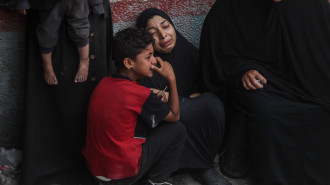
Why Dubai, Jeddah and Muscat are in desperate need of climate-proof investment

Dubai, with its glittering skyline and coast of resort islands, can feel a world apart. But the unprecedented rainfall that hammered the Middle East’s most famous megacity served as a reminder that extreme weather is becoming a reality there as everywhere else.
The mid-April storm — the largest to hit the United Arab Emirates in 75 years — flooded streets, shuttered highways, and caused several cancellations and delays at Dubai International Airport, the busiest in the Middle East and second-busiest worldwide.
But the fallout hardly stopped there.
Flooding also battered other Emirati cities, such as Ras Al Khaimah and Sharjah, and the UAE’s neighbour Oman might have suffered the worst of the storm’s effects.
Water subsumed much of the eastern coast and the Omani capital, Muscat, leading to a number of fatalities, including 10 school children trapped in a vehicle caught in the flood.
At least 21 people died in Oman, with another four lives lost to the flooding in the UAE. Some parts of Oman got 230 millimetres of rainfall in a several-day period, while one chunk of the UAE received 255 millimetres over just one day.
Caught off guard by the scale of the storm, Emirati and Omani authorities closed offices and schools and urged citizens to exercise caution and stay at home.
Yet experts suggested that even if this episode stood out for its deadly consequences, such cases of extreme weather should hardly come as a surprise in the era of climate change.
“Rainfall from thunderstorms, like the ones seen in UAE in recent days, sees a particularly strong increase with warming,” Dim Coumou, a climatologist at Vrije Universiteit Amsterdam, told Reuters.
“This is because convection, which is the strong updraft in thunderstorms, strengthens in a warmer world.”
Other experts were more equivocal. A report by World Weather Attribution, a collective of climatologists also known as WWA, noted that the infrequency of rainfall in the region and the resulting lack of data made a definitive analysis of climate change’s role difficult.
The group described its own assessment of the floods in Oman and the UAE as beset by “high uncertainty” in light of this caveat, but WWA concluded, “We have no alternative explanation for a trend in observations other than the expectation of heavy rainfall increasing in a warmer climate.”
The researchers behind the WWA report included scientists from Canada, France, the Netherlands, Pakistan, Saudi Arabia, Sweden, Switzerland, the United Kingdom, and the United States, speaking to the global interest in climate change’s link to extreme weather.
Saudi Arabia in particular has a stake: just two weeks after the chaos in Oman and the UAE, floods hit much of Saudi Arabia’s Red Sea coast, forcing the closure of schools in Jeddah, Khulais, Medina, and Rabigh and turning Saudi streets into rivers.
In some ways, this problem is nothing new. The same part of Saudi Arabia saw fierce storms last year and the year before, when floods carried away cars and killed two people.
The devastation has been even worse in other parts of the world, with flash floods contributing to deaths across the Middle East and North Africa.
The most notorious example came in September 2023, when a storm worsened by climate change caused the collapse of two dams in Libya and led to the loss of 6,000 lives.
A video that began circulating back then and purported to depict the Libyan catastrophe was, in fact, a 2016 recording of floods in Saudi Arabia.
What stands out, then, is the extent to which countries like Oman, Saudi Arabia, and the UAE have had the chance to prepare for extreme weather but failed to.
Whereas Libya could blame its lack of preparation for the September 2023 tragedy on political dysfunction and a dearth of funds, the countries of the Persian Gulf enjoy political stability, abundant riches, and a wealth of scientific knowledge; petrodollar-funded academic institutions such as King Abdullah University of Science and Technology near Jeddah host some of the world’s leading scholars on climate change at top-of-the-line research centres.
Yet basic issues have gone unresolved. As far back as 2009, the mayor of Jeddah linked a flood that claimed over 100 lives to a mundane challenge: the city’s insufficient drainage.
In 2015, Saudi authorities again admitted that Jeddah suffered from “a lack of adequate rainwater drainage systems” and “comprehensive water drainage in its streets and tunnels.”
While the regional authorities had already embarked on several ambitious projects to expand drainage by then, the recent floods indicate that the problem remains far from addressed.
Oman and the UAE are hardly doing better. The WWA report observed, “Across both countries, a high degree of surfaces with limited permeability and absorptive capacity from urban developments, inadequate drainage and the hyper-arid soils exacerbate the risk and severity of flash floods.” The authors urged “more proactive urban planning.”
Even as the Gulf’s energy superpowers pour money into what they are billing as eco-friendly smart cities, cities like Dubai, Jeddah, and Muscat are in desperate need of climate-proofing investment.
Though bread-and-butter issues like drainage lack the glamorous appeal of Neom, they have already proved to be a matter of life and death.



 Follow the Middle East's top stories in English at The New Arab on Google News
Follow the Middle East's top stories in English at The New Arab on Google News


